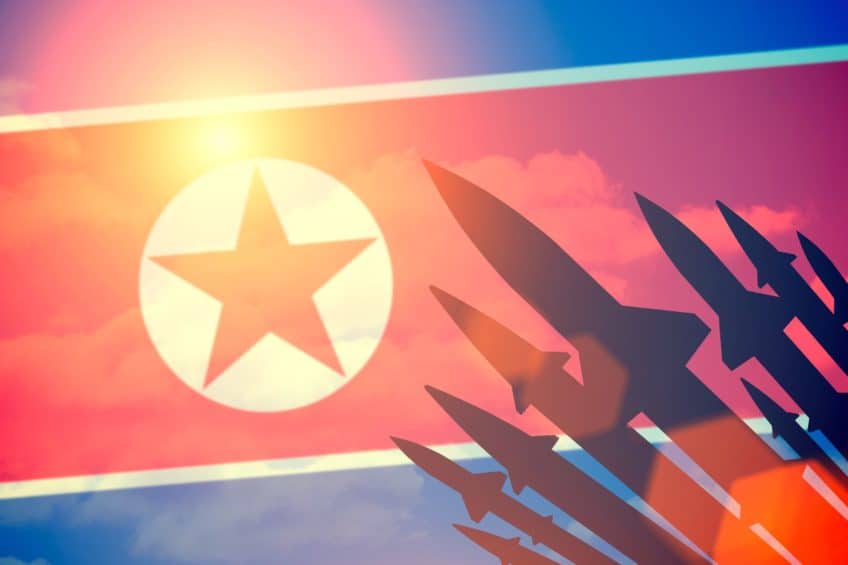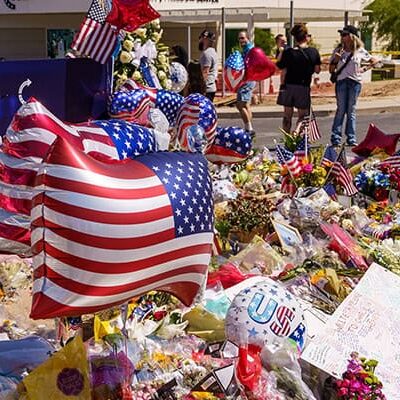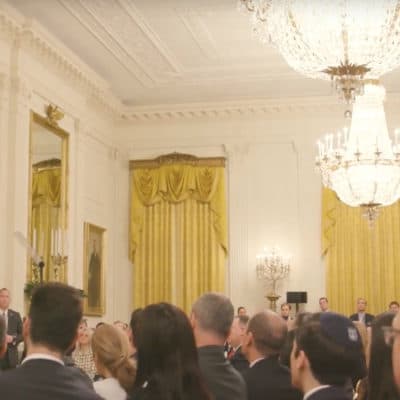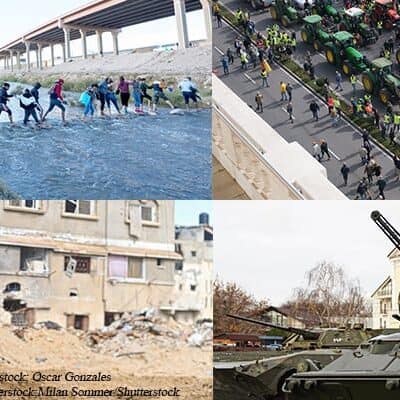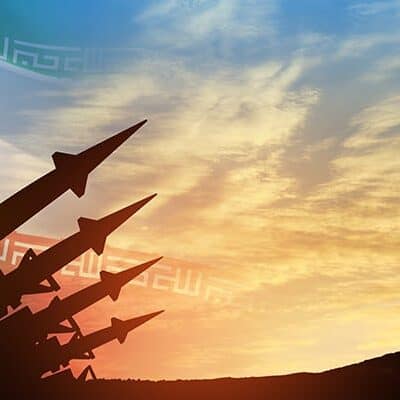Never in recent times have we seen a head of state make nuclear threats against the United States like we’ve seen from Kim Jong-un. It seems more than a little foolhardy of him, particularly in the age of President Trump. The world watched the epic military parade in Pyongyang recently, complete with intercontinental ballistic missiles, or replicas of them. A series of missile launch tests blew up suddenly leading some to speculate that perhaps the U.S. military had the ability to scuttle North Korean missiles remotely.
Then came the intermediate range missile test of May 14th. It was the longest range missile North Korea had launched to date. It flew for 30 some minutes, over 400 miles, and landed in the Sea of Japan only 60 miles off the Russian coast. Even so, Vladimir Putin warned (apparently President Trump) that there’s been too much intimidation of the North Korean leader.
U.S. Ambassador to the UN Nikki Haley says that Kim Jong-un is paranoid about everybody and everything. He fears the potential of a coup from inside his own regime in addition to international threats. Ambassador Haley is working to get members of the UN to clamp down additional economic sanctions against the North Korean regime in the hopes that they will be dissuaded from more bad behavior.
You probably remember the public murder of Kim Jong-un’s half-brother, carried out in front of security cameras at the airport in Indonesia. Two women ran up to him and clapped cloths soaked in VX gas to his face rendering him instantly dead. Clearly, it was a hit carried out by a state with access to the poisonous nerve agent. South Korea immediately accused Kim Jong-un of ordering the hit. Subsequent reports throughout the media speculated that Kim Jong-un was securing his rule against the possibility that there would be a blood-line successor to take his place in the event of his death or removal, and that officials in China favored his half-brother, Kim Jong-nam as a potential replacement.
But it’s not the first time Kim Jong-un had people executed who were perceived as a threat to his position. He had his uncle and close advisor to his father, Jang Song-thaek, arrested on live North Korean television during a politburo meeting. The arrest was carried out by Kim Jong-un’s devoutly loyal elder brother, Kim Jong-chul. Jang was subsequently accused of numerous treasonous acts and called “despicable human scum, no better than a dog…” in an official statement.
It is reported by defectors that Jang was forced to watch as his aides were executed by firing squad made up of anti-aircraft guns. The result was so gruesome that Jang reportedly passed out. Maybe the (presumably 50 caliber) anti-aircraft guns are no worse a way to go than a regular firing squad for those being killed, but it must be awful for the spectators. Later, Jang himself was executed by the same method as were aides and officials thought loyal to him. Numerous members of his extended family were reportedly rounded up and killed. A South Korean news agency reported that Jang’s nephew, O Sang-hon “was executed by being burnt alive using a flame-thrower.” Another report has one of Kim Jong-un’s perceived enemies being made to stand on a spot targeted by distant mortars so that no trace of him would remain.
When Senator John McCain recently referred to the diminutive dictator as “this crazy fat kid who’s running North Korea,” the regime responded by saying it came close to a declaration of war by the United States, because it “dared hurt the dignity of the supreme leader” and was therefore an attack on their entire national ideology and social system.
Despite the fact that an “armistice” agreement was signed by an American General representing the United Nations Command and a North Korean General representing the Korean People’s Army and the Chinese People’s Volunteer Army, no peace agreement was ever achieved. The recent history of Korea is incredibly convoluted, and the Korean War in fact was a loose end left unresolved at the end of WWII. Japan had ruled Korea from 1910 until the end of WWII when the Russians moved into Korea immediately after the United States dropped the nuclear bombs on Hiroshima and Nagasaki. The short version is that U.S. forces moved into South Korea to counter Soviet forces north of the 38th parallel, and Korea was divided into North and South as a product of the Cold War between the United States and the Soviet Union. Both North and South Korean governments considered themselves sovereign over the whole of Korea.
The Korean War was touched off when North Korean forces invaded the south on June 25, 1950 with support from both the Soviet Union and China. The UN regarded the action as an illegal invasion eventually bringing twenty other nations into the fray, with the United States bearing the vast majority of the military burden. Kim Il-sung, grandfather of the “crazy fat kid,” instigated the invasion of South Korea with the permission and cooperation of Stalin and Chairman Mao, with the goal of uniting both North and South under his rule. President Truman wrote that North Korean communism had behaved in the fashion of Hitler and Mussolini, and that intervention was necessary to prevent its spread.
Neither South Korea nor the United States were prepared for the invasion, and South Korea was very nearly conquered by communist forces which succeeded in capturing Seoul. General Douglas MacArthur brought in assets from U. S. garrisons in Japan and began strategic attacks to eventually drive back the invasion. MacArthur not only battled the communists, but the Pentagon and civilian leadership who worried that a wider war with the Soviets or China would result. After MacArthur liberated Seoul and handed it back over to South Korean rule, which had been accomplished by September of 1950, he received a secret message from Secretary of Defense George Marshall saying, “We want you to feel unhampered tactically and strategically to proceed north of the 38th parallel.”
By October 19th, 1950 ROK (Republic of Korea) forces backed by the UN Command (largely made of U. S. forces and led by MacArthur) had captured the North Korean capital of Pyongyang and were trying to cut off the communist KPA (Korean People’s Army) forces from escaping into China. MacArthur wanted to extend the war all the way into China to destroy the depots that were supplying the North’s war effort. A famous meeting between President Truman and General MacArthur took place on Wake Island to discuss the progress of the Korean War. MacArthur was confident that the Chinese would not get further involved.
But within days, the Chinese (PVA) launched a counter-offensive across China’s border with North Korea routing the ROK (South Korean forces) and U. S. forces prompting an evacuation. The Chinese forces fought all the way to Seoul again, but they outran their supply line, and a reinvigorated U. S. Eighth Army pushed them back to the environs of the 38th parallel where fighting “stabilized.” There were still many bloody battles, some of which are well known, but none resulted in significant territorial gains for either side.
For two years intermittent negotiations for an armistice went on while bombing runs and clashes continued. Ultimately, in July of 1953 the UN accepted an armistice proposal introduced by India which established a demilitarized zone along the 38th parallel and made arrangements for the exchange of prisoners of war and the dead. It was signed by the UN, which for all practical purposes had been represented by the U. S. military, and the Chinese (PVA) and North Korean (KPA) armies. The armistice provided for continued talks to ultimately result in a peace treaty. That never happened.
This abrogated and sanitized version of events is not meant to downplay the horrors or the sacrifices made in the Korean War. Official statistics from the U. S. Dept. of Defense show that there were 33,686 lives lost in battle and 2,830 non-battle deaths. South Korea reported 373,599 civilians killed and 137,899 military. The Chinese army is estimated to have lost some 400,000 soldiers with another 486,000 wounded, and the North Korean forces (KPA) lost 215,000 in battle with another 303,000 wounded.
The Chinese and North Koreans estimated American losses much, much higher (over 600,000) and also claimed to have won the war, a claim they make to this day. Nearly every major building in northern Korea was destroyed, and every city and town largely reduced to rubble. Concern that the Soviets or Chinese were committing substantially more assets into Korea led the United States to prepare for the use of nuclear weapons. Several were deployed, armed and ready except for the nuclear core.
But the prospect of an all out war between the U. S. and China led to fears that Russia would take the opportunity to try to conquer all of western Europe, and that was one of the reasons that atomic bombs were not employed.
Now you probably know way more than you ever wanted to about the Korean War, and we barely scratched the surface. But it was Kim Jong-un’s Grandfather, Kim Il-sung, who was the principal in alliances with communists Stalin and Mao who originally sought to rule over the entire Korean peninsula following its occupation by Japan. The situation is somewhat different now, with Japan no longer a threat. But Kim Jong-un, defectors say, has North Koreans in a constant siege mentality, worried that the civilian population is under threat of attack by the United States.
He’s also convinced the population that North Korea has the strongest military on earth, and that it can obliterate the U. S. if hostilities should break out. As mentioned at the beginning of this article, after several short-range North Korean missiles blew up shortly after they were launched, a successful medium-range missile flew some 430 miles successfully. Since then there have been at least three more successful tests, with one missile landing inside Japanese territorial waters. That incident led Japan to lodge protests with the UN.
Now the world wonders just what capabilities Kim Jong-un may actually have. We know that North Korea has conducted successful nuclear tests, but no one seems sure how close he is to being able to arm the longer range missiles that might be able to reach parts of the United States. We do know that the U. S. is testing the ability to destroy incoming missiles at high altitude, and those tests are described as attempts to counter North Korea. But little Kim is keeping up the provocations, including verbally. He recently promised the United States “a bigger gift package,” whatever that entails.
We know of the events which comprise the Biblical scenario of the end time, and it doesn’t seem as if North Korea factors in. But as this story and many others show, there can be enormous wars and loss of life for which there are no prophecies. We cannot be complacent in the knowledge that the major players in the Biblical scenario have not yet aligned. North Korea is a credible threat to millions in South Korea as well as Japan. But Kim Jong-un seems obsessed with posing a threat to the United States as his propaganda films show the White House or an American city going up in flames as a result of a North Korean strike. We must hope that U. S. military planners have a handle on the actual capabilities of the diminutive mad man, and pray to God that our homeland will be protected.

